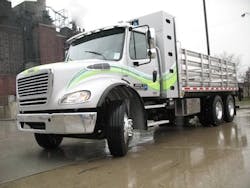Natural Gas Is Hot, But Comes at a Price
Here in the United States there’s supposedly a century’s worth of natural gas underground, waiting to be pulled up, processed and used as fuel. It burns cleanly with few exhaust emissions, and although recovery by deep-well “fracturing” with high-pressure fluids carries environmental risks, using gas will lessen our dependence on foreign oil.
Natural gas is also the feedstock for production of the majority of propane, more properly called liquified petroleum gas or LPG, another alternative to petroleum-based fuels. Gas’s abundance has already driven down pricing to where it’s about 40 percent cheaper than gasoline or diesel fuel. Pipelines carry gas to many parts of the country, and fueling stations for motor vehicles are springing up in some places.
A lot of the gas can be used in trucks, and some say it should. But there are a couple of catches: Gas must be compressed or liquified through cryogenic cooling to reduce its volume so enough can be carried to yield a reasonable driving range. And vehicles must be equipped to carry and burn it. This can get expensive, as we’ll see.
That it can be done is proven by these two examples: a Freightliner M2-112 and an International WorkStar outfitted for compressed natural gas, or CNG. Both are demonstrators with flatbed bodies that can be weighted to simulate real loads. They were among two dozen or so hybrid and alternative-fuel vehicles available for sampling earlier this year at the National Truck Equipment Association’s Work Truck Show and Green Truck Summit in Indianapolis.
The M2-112 had an 8.9-liter Cummins Westport ISL-G, which is optional from Freightliner and other builders. Westport Innovations, based in Vancouver, B.C., has other products, including a dual-fuel version of Cummins’ 15-liter ISX. The ISL-G is a variation on the medium-size, heavy-duty diesel that’s increasingly popular in construction trucks.
The WorkStar had a 7.6-liter Phoenix engine developed by Emissions Solutions Inc. It’s based on Navistar’s MaxxForce DT (formerly the 466-cubic-inch DT 466) but is not called a MaxxForce. Navistar has said it will soon have larger engines fitted to burn natural gas, so we know there’s a trend in the works.
Each of the engines makes less than legally allowable soot and nitrogen oxide emissions, so needs no particulate filter or, in the case of the Cummins, urea injection on its exhaust system. And neither needs credits from the Environmental Protection Agency to run legally. A look at their exhaust systems is like going back 10 years, because there’s only a muffler with an integral oxidation catalyst to help break down certain emissions.
So the exhaust systems are relatively cheap and
lightweight. However, they are more than offset by the natural gas fuel system and a stack of pressurized fuel tanks aboard the trucks. The tanks are the priciest
components, costing about $35,000 per set, because they are precisely made pressure vessels built in small volumes.
Enough for local running
Each truck has five “bottles” that store gas at up to 3,600 psi and hold the equivalent of about 75 gallons of diesel fuel. As shown in the photos, they take up roughly four times the space of a similar-size diesel tank. The gas is regulated to below 200 psi for fuel handling and burning.
The Phoenix’s ratings go from 210 horsepower and 520 lb.-ft. to 300 horsepower and 860 lb.-ft. The Cummins Westport’s larger displacement allows its ratings to be stronger: 250 to 320 horsepower and 660 to 1,000 lb.-ft. This is enough for many applications, especially construction trucks which run empty a lot of the time.
Both use spark ignition, so their compression ratios of 10.5:1 are far less than a straight diesel’s. Thus they are quieter and smoother, something I noticed with each truck. Both engines ran well, with their electronic controls delivering fuel steadily and efficiently. A lot of programming work was needed to achieve proper performance, the builders’ representatives said.
Power and torque is more peaky with natural gas than with diesel, so off-the-line performance might suffer. But an Allison automatic transmission, which is part of the gas-engine package, nicely compensates. Its torque converter multiplies the twist available when moving away from a dead stop, and revs stay more steady in each of the transmission’s six ratios. The engines briskly propelled both trucks. I could’ve out-dragged any comparable truck with a manual tranny because its acceleration is interrupted between gear change and a driver can shift only so fast.
This was on streets in the heart of Indianapolis. It might’ve been different on surrounding freeways where higher road speeds prevail. Speed demands horsepower, and drives in other gas-powered heavy trucks on other occasions have shown that their limited-displacement engines must work hard to keep them moving. Just as with a diesel, sustained highway running would require a larger gas engine.
An Allison has other benefits, including ease of operation and cushioning of the driveline, which can justify its price premium over a manual gearbox. That an Allison is mandatory with a medium-heavy duty gas engine adds somewhat to the upfront cost of buying one of these trucks, or any other that uses a similar powertrain.
Again, the biggest cost is for the CNG bottles or a cryogenic tank for liquified natural gas, or LNG. Such a truck costs at least 50 percent more than one with a straight diesel. Government grants can offset much of the premium, and lower fuel costs can provide a decent payback. Some proponents say that natural gas’s cheapness alone is enough to pay off a truck’s higher initial costs. And they come with “green” bragging rights.
I say they’re neat to drive, and most drivers will probably agree once they’re briefed on how a natural-gas truck operates and learn how to pump up its tanks. They’d literally “gas up” the truck and “hit the gas pedal” instead of the accelerator. That adds precision to everyday conversations, green or otherwise.
